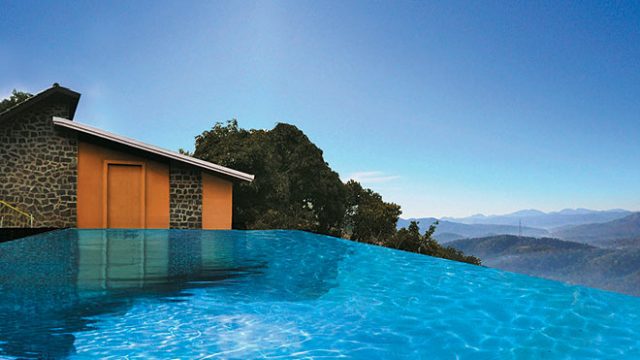We touch down in Kochi, the nerve centre of Kerala on the first day of June, and brace ourselves for a five-hour drive uphill along winding roads to Thekkady. We had zeroed in on Poetree, newly acquired by Sarovar Portico, for our let-us-finally-sample-the-Kerala-monsoon vacation. As we drive past small towns at regular intervals, deep-deep green on both sides, our apprehensions about the too-long drive—a good 170km—right after a long flight are forgotten. After just 15 minutes of slouching-sulking, we all sit up and hungrily track the trees whizzing past.
We arrive just as it is beginning to get a little dark with clouds, and find a lovely breeze waiting up for us. But no rain yet! A traditional welcome ushers us to the comfortable bed and big bathroom in the Reserva suite. The balcony, styled ‘the private deck’, serves up sweeping, unobstructed views of Thekkady town, sprawling ridges, wooded valleys and Periyar Lake far away. Next morning, we realise it is also a great spot to watch the sunrise, which incidentally is spectacular three days in a row.
But that first morning, we curled up there, sipped some masala chai and gorged on onion and banana bajjis. The partner’s camera came out; and I decided to finish the book I’d begun in the flight, with the lights of the city twinkling up at me from below…Nice way to end a day I tell you! The very vibe in the resort invites you to relax and let go. And that’s what we decided we’d do while we waited for the rain to come say hello.
Dinner at the Kusini restaurant was a simple buffet, with a nice mix of staples from both North India and Kerala. Next morning, after a simply Southern breakfast of idli, vada, appam and vegetable stew, we went for a round of the 9-acre property with GM Ajit Jose. Besides the rooms and suites, there are eight cottages and a stunning duplex, Prive Presidential Suite, that houses a whirlpool tub on the top floor. I particularly loved the thatched-roof cottages that come in two shapes—oval and round. They are built from local elephant grass by the indigenous Mannan tribe and the entire cottage is made with local sustainable materials, showcasing a pleasant blend of tribal and modern architecture within the mud-splashed walls
As these cottages, which are several years older than the rest of the recently enlarged resort (and have been popular with European travellers even before Sarovar management stepped in), are perched bang in the middle of an almost-jungle, I could actually imagine snuggling in bed listening to a soothing symphony of cicadas and waking up to find a rare bird serenading me from the private balcony. Splendid isolation! According to Jose, September to January is when a lot of enthusiasts come glamping for months to study and photograph a certain species of wood spider that has almost taken over this jungle. Apparently these arthropods are only found in Thekkady and Munnar, and known for the big and colourful webs they weave. We were lucky to spot one, in spite of the fact that it wasn’t supposed to be around in this season.
A lot of thought seems to have gone into making Poetree this experiential eco resort. With 70% of the jungle left untouched, only 30 trees were felled to put together the place and some 400 more were planted. The garden sits at the back with birds flocking at dawn, past a butterfly garden, a small spice plantation (cardamom, pepper, nutmeg), a herb garden, banana and jackfruit and strawberry patches. The trees of its moniker? Those are teak. Thekkady is the valley of thekku, teak.
The poetry is not restricted to Mother Nature’s pen. The resort has some striking functional art too. One wall in the restaurant showcases a traditional Syrian kitchen, and there is a toddy shop set-up in the bar. The lobby has a stunning art wall that depicts five icons of Thekkady: wildlife represented by the elephant (what else?), a log of teak to stand in for the forests, a bow and arrow from one of the local indigenous tribes, water to recall the lake and cardamom to represent the Kerala spices. But the piece de resistance is a huge installation in cement by a local artist, near the pool, which had me entranced for several minutes,
As did the stars, brought closer by the library’s telescope, after a relaxing contemplation of cocktails at the Shaapu Bar overlooking the pool and Periyar. A rooftop restaurant is also in the works that will offer experiential dinners.
So passed three endless days of calm, plus some excitement in a boat and on safari in Periyar, which I wound up rather fittingly with a soothing ayurvedic massage at the Serena Spa. Soothing enough that I forgave the late monsoon, which refused to make an appearance during our stay there.




